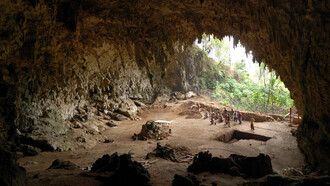Molti son li animali a cui s'ammoglia
e più saranno ancora, infin che'l veltro
verrà, che la farà morir con doglia.
Questi non ciberà terra né peltro,
ma sapïenza, amore e virtute,
e sua nazion sarà tra feltro e feltro.
Di quella umile Italia fia salute
per cui morì la vergine Cammilla,
Eurialo e Turno e Niso di ferute.
Questi la caccerà per ogne villa
fin che l'avrà rimessa ne lo 'nferno
là ove 'nvidia prima dipartilla.(Dante, Inferno)
Jaan Toomik is one of the best known Estonian international artists, probably the best known. His artwork embraces diverse disciplines such as painting, performance art, video art, and film direction. The core of his poetics is “a metaphysical, biocentric and shamanic vision of the world”. His work, for the most part naturalistic and autobiographical, is focused on the age-old subjects of life and death, religion and spirituality, that bind the human body to the cyclic processes of nature.
While researching Toomik’s work it occurred to me that it seemed like a journey not unlike that of Dante, who rises from Inferno toward Paradise. A journey that represents the life path of every human being. It is an autobiographical journey in which we can recognize everyone, and which leads us to look into our intimacy, into the depths of our souls, into the dark forest in which we have lost ourselves and in which we feel alone in the search for a guide, in the search for the other. We recognize everyone in the Dante who wishes to climb the shining hill alone. But it is in sociality, thanks to relationships and to the collaboration and help of others, that we are able to climb the hill.
After the first Italian retrospective dedicated to the Estonian artist and produced in collaboration with the The Center for Contemporary Art of Estonia in Tallin, Jaan Toomik returns with a new oeuvre that includes a piece of sculpture, some videos and a series of paintings created ad hoc for the exhibition. The human being remains central, personified by Toomik himself who is able to be, in an original and personal way, both subject and precarious object, post-modern and globalized, without ever losing his playfulness and self-irony.
One of the main artworks in the show is the sculpture “Ritual” (2021) that represents a nocturnal act carried out by by a sleepy person whose body levitates as he performs this biological need. In all of Toomik’s work there is a particular irony, which in this case is connected to age. At a certain age, at a certain existential ripeness, there are inevitable actions that cannot be ignored. In effect we are ourselves, with all our positive qualities and our defects, but we no longer have the need to conquer anything, we are satisfied and thus we have no limits, we don’t want to put things off till tomorrow, we no longer fear to say what we think, do what we want to do and we live that which is natural as it should be lived, as a ritual.
Other works that Toomik created for the show are paintings with flies. “From the the 800,000 pieces of data regarding 18,000 species gathered by UCL researchers in 6,095 places around the globe it has been found that in areas where intensive agriculture coincides with a higher level local climate change the abundance of insects is nearly half of what it is in areas less damaged by anthropic activity.” This is the dramatic and worrying confirmation of diverse studies that corroborate that which entomologists have been saying for year apropos of the fall of the number and the diversity of insects. There are many causes, most of which are of human origin, as in the case of the impact of light pollution on fireflies; or the effect of fertilizer on butterflies; or the encroachment of urbanization; or deforestation and, above all, the change in how the soil is used, and climate change.
As I said a new series of paintings created ad hoc for the exhibition reflect on this subject. We have an accidental entanglement of insects in flight that, if we look at them through a different lens, also becomes a death scenario in which the insects seem splattered on the canvas. The color is bright yellow, that is decorative but draws the eye; it’s telling us that we must be careful, that there is something important, that something important is happening to our planet, and thus to us; that we are doing something whose consequences are important for the future of all of us. At the end, there are videos and paintings inspired by men struggle. Homo homini lupus. The philosopher Hobbes quotes a Platonic locution from his The Only One with the Asses to allude to human selfishness, to describe the “the state of nature” where humans, blinded by selfishness, fight one another for survival. History is full of human belligerency, from Cain and Abel to the current Russian aggression against Ukraine. We fight for power, for hegemony. In this series created with spray paint that accentuates the expressivity of the action, the intensity, the passion, the instinct; there are men (the “male power”) that fight among themselves, and this struggle becomes “viral” thanks to the sharing on social media (in one of the paintings a man is shown filming the scene with his cellphone).















